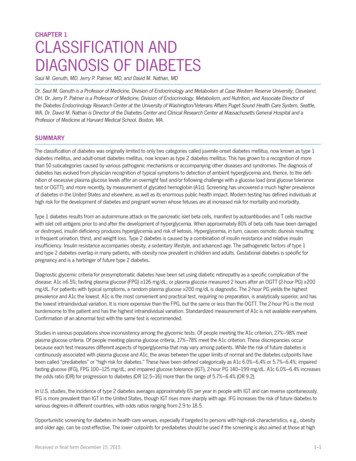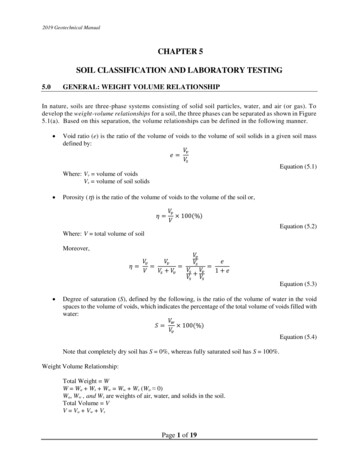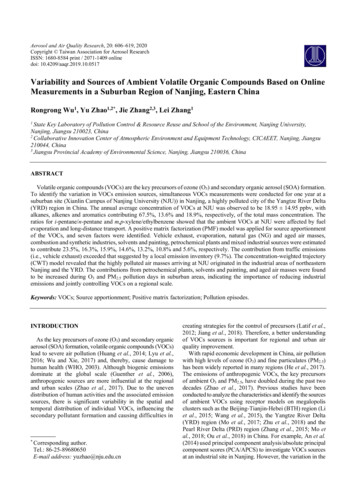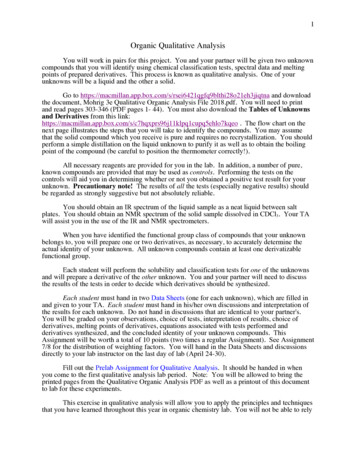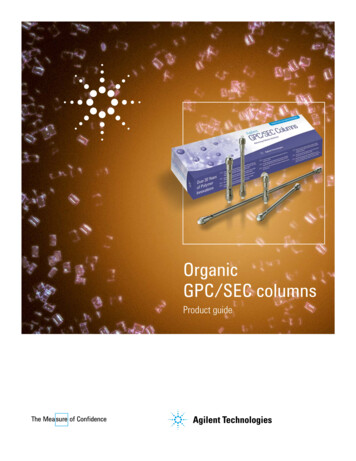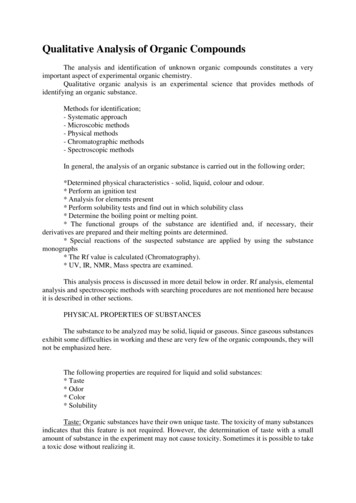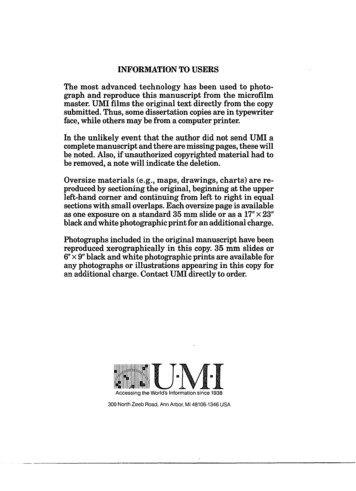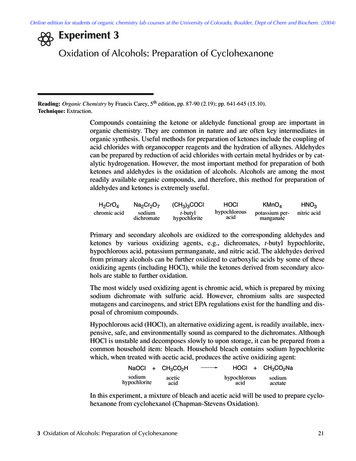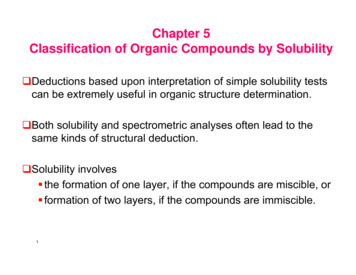
Transcription
Chapter 5Classification of Organic Compounds by Solubility Deductions based upon interpretation of simple solubility testscan be extremely useful in organic structure determination. Both solubility and spectrometric analyses often lead to thesame kinds of structural deduction. Solubility involves the formation of one layer, if the compounds are miscible, or formation of two layers, if the compounds are immiscible.١
The solubility of organic compounds can be divided into twomajor categories:¾ Solubility in which a chemical reaction is the driving force¾ Solubility in which simple miscibility is the only mechanisminvolved, such as dissolving ethyl ether (CH3CH2OCH2CH3) incarbon tetrachloride (CCl4)٢
Solubility Tests for the Identification of Functional Groups٣
٤
Test the solubility of a substance in WaterA substance is said to be 5% NaOH“soluble” if it dissolves to the 5% NaHCO3extent of 3.3 g/100 mL of solvent 5% HCl Cold concentrated H2SO4 This can provide three kinds of information:Presence of a functional group.For instance, because hydrocarbons are insoluble in water,observing that an unknown is partially soluble in waterindicates that a polar functional group is present. (i)٥
(ii) Solubility in certain solvents often leads to more specificinformation about functional group.i.e., solubility in 5%NaOH of a waterinsoluble unknownis a strong indicationof an acidicfunctional group.(iii) Certain deductions about molecular size and compositionmay sometimes be made from solubility tests.Example: in many homologous series of monofunctionalcompounds, the members with fewer than about 5 carbonatoms are water soluble, whereas the higher homologs are٦insoluble.
¾ Procedure for Determination of Solubility: Solid: R.T.warm for water solubilitycool to R.T. Liquids: 25 mg (0.05 ml – one drop) in 0.75 mL (15 drops) Testing with litmus paper Heat should not be applied for ether solubility, and also whensolubility in acid or alkali is being determined, because itmight cause hydrolysis to occur. If the mixture is shaken thoroughly, the time required for theunknown to dissolve should not be more than 1 to 2 min. Solubility in Concentrated Acid9 Place 0.6 mL of conc. H2SO4 in a test tube, and add 0.05 mL( 1 drop) or 25 mg of the unknown.9 Unknowns that react with H2SO4 to produce heat and/or colorchanges should be classified as soluble even if the sampledoes not appear to dissolve.٧
The dielectric constant is themeasure of the ability of thesolvent to separate ioniccharges. The dielectric constant isrelated to the polarity of thesolvent. To dissolve ionic compounds,a high dielectric constant isrequired, but it is not the onlycharacteristic of an effectiveion solvent.Example: HCN is a very poorsolvent for salts such as NaCl٨ The high dielectric constantand hydrogen-bonding abilityof water (and other hydroxylicsolvents) which combine tomake it a good solvent forsalts, also make it a poorsolvent for nonpolarsubstances.
Like dissolves like9 Most organic molecules have both a polar and a nonpolarentity, it can be deduced that solubility would depend on thebalance of the two parts.9 As the percentage of the hydrocarbon portion increases,water solubility decreases and ether solubility increases.٩
Generally, solubility of a substance is inversely related to itsmelting point: high melting point – low solubility. Among cis-trans isomers, the cis form generally is moresoluble.١٠
In general, an increase in molecular weight leads to anincrease in intermolecular forces in a solid and decreasedsolubility.١١Similarly,glucose vs. starch or cellulose, and amino acids vs. proteins
Compounds having a branched chain is more soluble thanthe corresponding straight-chain compound.9 Branching lowers intermolecular forces and decreasesintermolecular attraction. The position of the functional group in the carbon chain alsoaffects solubility.١٢
Solubility in Water Water is a poor solvent for hydrocarbons. Presence of double bonds, triple bonds or aromatic ringsdoes not affect the polarity greatly – similar to alkanes intheir solubility. Substituting halogen for a hydrogen decreases the watersolubility. Salts are extremely polar and are usually water soluble. Acids and amines are more soluble than nonpolarcompounds (due to H-bonding). Solubility of amines decreases as the basicity decreases. Many tertiary amines are more soluble in cold than in hotwater (at lower temperatures, the solubility of the hydrates isinvolved).١٣
Solubility in 5% Hydrochloric Acid Solution 1o, 2o, and 3o aliphatic amines form polar ionic salts with HCl.9 Aliphatic amines are readily soluble in 5% HCl. The presence of conjugated aryl groups decreases thebasicity of the nitrogen atom.soluble in 5% HClinsoluble in 5% HClinsoluble in 5% HCl Disubstituted amides (RCONR’2) of sufficiently high molecularweight to be water insoluble are soluble in 5% HCl solution.١٤
Solubility in 5% NaOH and 5% NaHCO3١٥
Ka 1x10-10 insoluble in NaHCO3 soluble in NaOHsoluble in NaHCO3soluble in NaHCO3١٦
Aldehydes and ketones are sufficiently acidic to react withaqueous alkali, but they are too weakly acidic to dissolve toany measurable extent in 5% NaOH solution. When two carbonyl groups are attached to the same carbon,the acidity increases sharply. Esters with five or six carbon atoms that are almostcompletely soluble in water may be hydrolyzed by continuedshaking with 5% NaOH solution. The alkali should not beheated and the solubility or insolubility should be recordedafter 1-2 minutes.١٧
Solubility in Organic Solvents The solubility of organic compounds in organic solvents shouldbe determined in order to plan for a variety of laboratoryoperations. These include choosing solvents for9 organic reactions,9 dissolving substrates for spectral analyses,9 cleaning glassware,9 extraction,9 Thin layer and other chromatography,9 Crystallization.١٨
١٩
Solubility in Cold, Concentrated Sulfuric Acid Cold, concentrated H2SO4 is used with neutral, waterinsoluble compounds containing no elements other thancarbon, hydrogen and oxygen. If the compound is unsaturated, is readily sulfonated, orposses a functional group containing oxygen, it will dissolvein cold, concentrated H2SO4 Alkanes, cycloalkanes, and their halogen derivatives areinsoluble in H2SO4٢٠
Simple aromatic hydrocarbons, and their halogen derivativesdo not undergo sulfonation and are insoluble in H2SO4 However, the presence of two or more alkyl groups on thearomatic ring permits the compound to be sulfonated.٢١Dissolve readily in H2SO4
٢٢
٢٣
٢٤
THE END٢٥
Solubility in Organic Solvents The solubility of organic compounds in organic solvents should be determined in order to plan for a variety of laboratory operations. These include choosing solvents for 9organic reactions, 9dissolving substrates for spectral analyses, 9cleaning glassware, 9extraction, 9Thin layer and other chromatography,

